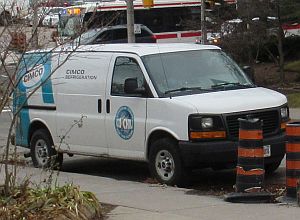Comments?
For the basics, see
- Website & Privacy Policies
- How To Get Involved
- The Role of the Park
Search options:
Department Site Map
Custodians:
Newsletter Winter 2019
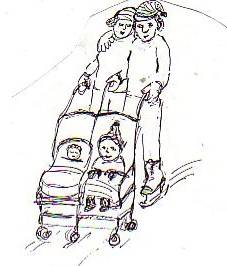 rink access for strollers |
This newsletter is published by CELOS, the Centre for Local Research into Public Space. Since 2000, when this little organization began at Dufferin Grove Park, we’ve been doing what we call “theoretical and practical research” into what makes public spaces – like parks – more hospitable and more lively. We’ve been researching what works and what doesn’t, and we’ve documented a lot of what we’ve seen and done, in the newsletter and on our five websites.
Perfect weather for outdoor rinks in December
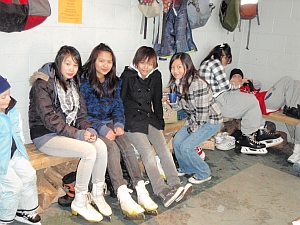
a place to warm up and be with friends
The rink season in December was about as good, weather-wise, as it could be. No big storms, no really warm spells of 15 degrees, no deep-freeze like last year at this time. It’s also good to see that outdoor rinks citywide have gradually followed Dufferin Rink’s long-standing practice of being open on holidays – Christmas Day, Boxing Day, and New Year’s Day. Even a few years ago, most change rooms stayed closed on those days. In 2011, park friend David Rothberg made the news by donating money to keep all three ward 18 rink change rooms/ washrooms/ skate lending/ kitchens open for the stat holidays – Wallace and Campbell as well as Dufferin. Recently, keeping the change rooms open caught on citywide. Leading by example!
Skate lending across the city:
At a Community Development and Recreation Committee meeting last July, Parks and Rec general manager Janie Romoff said: "We did have a hundred pairs of skates donated in the Regent Park area last year, and we are putting them together as a pop-up opportunity where they can sort of rotate to a number of rinks for that lending opportunity." Although Ms.Romoff didn’t specify, she was talking about the donation that CELOS offered in 2017 to any outdoor rink in the city – but which all of them first turned down. Howard Dayton, the director of recreation, told city councillors that “there's a cost of approximately about a seven to eight thousand dollar subsidy a season from the city” to do skate lending at Dufferin Rink. But he hadn’t done his homework – in fact the park accounting shows that Dufferin Rink skate lending has always paid for itself (including staffing), even at a cost of only $2 a pair to rent.
City council asked Ms.Romoff to look into putting on only one “pop-up” skate lending event – at Regent Rink – this coming Family Day. Until then, over 100 pairs of skates are in a storage room somewhere in Etobicoke. None were used over the holidays. That’s the bad news. The good news is that when rinks management comes to its senses, a very friendly, very detailed how-to slide show, made by experienced Dufferin Rink staff in 2010, is already posted on Youtube, here. Ready to go, for any or all outdoor rinks that want more skaters.
Strollers on the outdoor rinks, and the accessibility act
Ontario’s accessibility act specifies that it applies to “Ontarians with disabilities,” but many people are not fond of such a negative descriptor. Just because I have arthritis in my knee and have trouble walking, for example, doesn’t mean I am defined in some broad way as DIS-abled. I just need to use a bike to get around instead of walking long distances. So I need curb cuts and good snow clearance in winter, when I bike to the park. Then I can bike where I want, just like people who get around by walking. Stopgap’s Luke Anderson, who uses a wheelchair, told us he prefers the expression “people who use wheels” to “wheelchair-bound.” When he spoke at the September 30 park meeting, Luke pointed out that the people who use wheels include parents and caregivers of babies, who use strollers – and therefore need curb cuts and good winter snow clearance and kneeling buses and subway elevators as well – or they can’t get around like people without strollers. Such adaptations are a win-win for everybody.
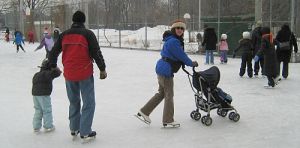
no accident with a stroller in almost 20 years
Nobody would think of telling a woman or a man with a stroller to stay off the bus, even if it’s a bit inconvenient for other passengers, and even if everybody has to be careful not to trip over the wheels. But if parents want to take two children to skate at an outdoor rink, and one child is a baby in a stroller, the rule is “go away, and come back when you no longer need to use wheels.” Access denied. “No fun allowed here for you, parents and children.”
Toronto is the world capital of mechanically-cooled outdoor rinks (we have almost 60), so that’s a lot of access – and fun – not allowed.
At Dufferin Rink, it never made any sense to the people who ran the rink to bar parents or caregivers of young children. So good skaters with babies in strollers have been able to skate here for most of the last 20 years. In that time, there has never been an accident involving a stroller. There’s been a lot of family fun, though.
Dufferin Rink had a real-time experiment showing that strollers are not causing accidents – wonderful. But now strollers are once again not allowed on the rink.
The law says Ontarians have the right to equal access if possible, and the 20-year Dufferin Rink experiment shows strollers are fine. It’s time for city authorities to change the rule everywhere. If not, then maybe it’s time for parents and friends of young children to make common cause with Luke Anderson and other people who use wheelchairs with the slogan – remove the barriers to participating in the social life of the community – for everyone.
That could be interesting.
News flash:
Shortly after this newsletter was published, the rink staff told a woman to get off the ice with her child in a stroller, that there was a long-standing rule against strollers on the ice. The skater and her sister, both at the rink with their families, complained to their two different councillors. After some back and forth, Councillor Paula Fletcher's assistant wrote back:
I have been corresponding with Todd Davison from Community Recreation at the City. He informed me that strollers are usually allowed on the ice if not being used as a skating aid and if the person is a confident skater. This is an issue he has been working on and he will let staff know about this.
Excellent, access for families with small children is back.
Feb.6, 2018: Public meeting about the reconstruction of the rink and clubhouse
If the current city plan goes ahead, the rink clubhouse and the rink pads will be renovated/rebuilt from scratch, from 2020 until 2022 (or longer if there are construction delays). That means the rink pads will be unavailable for winter skating and warm-weather skateboarding/ball hockey/bike polo/fall farmers’market during those years. Depending on the scheduling and extent of the clubhouse renovations, all food programs including Friday night supper, pizza days, and the playground cob café will also be stopped for one or two years, since there will be no kitchen available for food preparations.
Why is this happening? (good question!)
City planners say that the building is old (25 years), the hockey rink has the wrong dimension, the refrigeration machinery could use replacing, and “the city has identified an opportunity” to revitalize the northwest corner of the park. The architectural firm of DTAH has been hired for $700,000 to make the plan and supervise the construction.
The first reaction of many park users was “things are fine as they are, fix whatever is broken but don’t renovate what’s already working well.” So the city hired a company specializing in community consultations, and put together a “community resource group” of people who volunteered (now about 15). Several members are planners in their professional lives. Some members are there to defend a particular interest: the market, Clay and Paper Theatre, skateboarding, bike polo (not, for some reason, shinny hockey, although some shinny players have begun to take notice). The group has so far had five meetings, with six more to come.

making the zamboni café
The architects say that a big problem with the clubhouse is that it’s not “purpose-built.” True enough: it was meant to be a three-months-of-the-year building for housing the rink machinery and the ice resurfacer, and for people to change in and out of their skates. For the other nine months it was meant to be locked. Instead, over the years the building was continuously adapted for other uses, through an informal partnership between park friends and a gradually increasing number of park program staff. The adaptations involved knocking down a wall, adding four eye-level windows plus two little kitchens, squeezing in some skate lending.
This kind of gradual adaptation has a name: “how buildings learn.” But it’s not a good fit with current fashions in professional design. So the city has allocated $4 million for a complete makeover. There are five possible plans on the table so far. Sample link: Option 2 . Three plans involve demolishing the rink clubhouse and rebuilding it to the north or the east of the rink pads. All five plans call for a long hallway with a bench for skate changing separated from a “multi-purpose room.” A commercial kitchen with a snack bar counter would be at the end of that hallway. All plans call for the demolition and rebuilding of the two rink pads to get slightly different dimensions.
Building Accessibility
The rink clubhouse was originally built to be accessible, so there’s no curb up from the sidewalk to the gradual slope of the entrance path (even so, the design team proposes a much longer switchback access path). There’s no unevenness at the threshold between the entrance path and the door into the building, although at the fifth “revitalization” presentation on Dec.11, the design team seemed to think that there was a step-up. Each washroom has a wheelchair cubicle. The entrance and the interior work for wheels, and so does the exit heading south.
The multi-purpose room
Most people would say that the main change room in the rink clubhouse has been a multi-purpose room for a long time already. Volunteers removed an original centre wall, after the city gave its permission in principle in 1996. (Management wanted the community to fundraise $10,000 for the removal, so volunteers took the wall down themselves instead, which took about 10 hours over a weekend and cost nothing.)
Despite the many current uses of the adapted change room (puppet-making workshops, cold-weather market, community suppers, much-used winter social space) the plans all call for a new multi-purpose room (3), with the skate-changing corridor separated out. It’s not clear why. Clay and Paper Theatre is asking for a dedicated space, but the new room is unlikely to be given over to them. The market is too crowded in winter, but since all plan versions call for the winter market space (the garage) to be turned into a large commercial kitchen (K), the multi-purpose room would be too small to solve the market problem. Is the designated multi-purpose room a possible new revenue source for the city, to be rented out for parties or events, or used for income-generating after-school child care? Maybe so, but nobody’s saying.
Mystery book-keeping
Back in December, Keith McDonald, the retired head of the City of Toronto’s Open Data portal, tweeted: “More citizens need to join the request for better accounting and practices! Otherwise the confusion will carry forward another generation +. How can we tell what to spend when we can’t tell what was spent!”
You can say that again. Here’s a case in point.
The Northwest Corner Revitalization Project was announced back in 2016, partly on the grounds that the rink’s refrigeration machinery and the ice pads needed to be replaced anyway. CELOS asked the capital projects staff what exactly was wrong with the rink. The staff released a 2014 engineer’s report that said the equipment would soon reach the end of its projected life, calculated at 25 years.
Zamboni staff have often said that Dufferin Rink ice is better than some other city rinks. So we wondered – is there evidence to support getting rid of the existing cooling machinery, more than just a “best before” date? We asked to see the rink maintenance log, to find out if there had been an increase in equipment breakdowns. – No answer. We asked again a few times, until an impatient project co-ordinator finally said we couldn’t see the log. So last September CELOS asked through Freedom of Information (FOI): could we see the maintenance and parts-replacement record for the 25 years since the rink was rebuilt new in 1993?
FOI requests are supposed to get a response in 28 days. After 6 weeks we asked again. The FOI staff said that Parks staff couldn’t find records going that far, five years was the most they could do. So we settled for only a five-year record. But nothing arrived.
Then finally just shortly before Christmas, a letter came:
"The records...are not available [as] an electronic list...A search would include hardcopy and electronic records of numerous current and retired staff, including reviewing five years of log books to locate any relevant notations....[but]the City is not obligated to create a new record in response to a Freedom of Information request….Access, therefore, cannot be granted." Freedom of Information request 2018 - 02165
One of the mysteries here is that in 2004, the City government undertook an upgrade to its municipal book-keeping, first meant to cost about $7 million, and then in 2008 switched to a "full SAP build-out" eventually bringing the cost to more than $71 million. The system, called FPARS, is based on a data warehouse concept, and the data warehouse is supposed to collect detailed accounting and budget information from all divisions and agencies. Some analysts have suggested that FPARS is broken, despite its cost. The inability of Parks management to find even a five-year record of refrigeration maintenance spending at Dufferin Rink might be one proof. But Parks staff, through FOI, are not admitting they have a problem – it's our asking for the record is unreasonable. No wonder the former head of Open Data is tweeting that citizens need to follow up. Can it really be the case that $71 million wasn’t enough to make the city’s book-keeping work?
Global meets local, tries to swallow it
If the city bureaucracy can’t keep track of its spending or the functioning of its equipment, should the job be handed over to a global company that will collect that data and lots more, like Sidewalk Labs? These companies certainly want you to think so. And what about the city government’s “community consultations”? Many people have noticed that right now, you attend a few meetings where you’re asked to sit at separate round tables and answer carefully circumscribed focus-group types of questions. If that model of consultation often seems like an empty exercise, the professionals are eager to step up to gather ever more and better-calibrated opinions.
And the same professionals say they’ll be better at responding to the data they collect at the ground level, so they invite us to let them run the public spaces according to whatever data they collect, in place of the bureaucrats that seem to helicopter in and out. But surely putting ourselves in their hands is jumping into more trouble.
Sidewalk Labs, a division of Google, is starting to scare people with their program of total visibility and total control at Toronto’s waterfront. (And Sidewalk reaches beyond the waterfront: our long-time friends at Thorncliffe Park were recruited to try out Sidewalk’s data-collection app at their community park, unbeknownst to either the park users being logged with the smartphone app, or to the Waterfront Toronto panel working on data protection.)
Of course, if we stop Sidewalk Labs/Google from running the show, other global companies are ready to step up. Two years ago the City of Toronto hired the local architecture firm Public Work (co-founded by an architect formerly with the Northwest Corner design firm DTAH – lots of people in this design-tech world know each other). The city paid Public Work $600,000 to do a Public Space, Public Life study that has just been released now. Public Work partnered with a Copenhagen/San Francisco/New York company called Gehl Institute to gather their information for the study. The Gehl website, describing their company’s abilities, says they “collaborated with the MIT Civic Data Design Lab as they designed, fabricated, and tested sensor-enabled street furniture for the collection of public life data.” Gehl says their research approach is: “Use the city as a living laboratory to measure the quality of public life. Acquire new tools to take incremental steps toward meaningful and authentic neighborhood transformations.”
Toronto-based Park People recently worked with the “global innovation” firm Doblin, owned by the world’s largest “Professional services network” Deloitte, to research “how to create parks and public spaces with a greater sense of belonging.” Really. Apparently they came by Dufferin Grove…
Is there an escape from costly global “belonging” advice?
At the micro level, the people who work for these companies are a bunch of really nice people talking and putting up sticky notes onto community consultation displays and encouraging people to use apps that detail their likes. At the macro level, this new world is creepy.
Dave Bidini (in the West End Phoenix), writing about the rink house
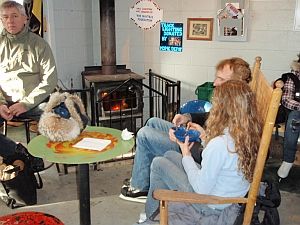
warm-up time in the Dufferin rink house
In the fall issue of the Phoenix, Dave Bidini wrote about his daughter. She went off to college in the fall, and Dave was remembering her
“skating around the cold square of Dufferin Rink eating their round, 50-cent confections: an English muffin spread with tomato sauce and cheese. She must have eaten hundreds of these, sitting on the bench in little skates near the hearth, parka hood down, cheeks blazing red, eyes cast around the room at the winter carousel of neighbours….Dufferin Grove is perfect – and the rink house is unlike any I’ve ever been to anywhere in the world, and I’ve skated everywhere – you can look it up….[H]anding it over to the city to run in the usual bureaucratic way means losing too much, including our memories, mine, yours, our neighbours.“
Back issues of the Phoenix can be found in the magazine rack in the rink house, near the woodstove.
Fake news
There’s a handsome blue plaque on the outside rink house wall near the skate lending room. It shows the logo of the Toronto Maple Leafs and the logo of MLSE (Maple Leaf Sports and Entertainment), and expresses gratitude for their support of the “skate library.” But in fact, the skate lending collection mainly consists of two big donations in 2003 and 2009 from the NHL Players’ Association, plus one donation (and lots of day-to-day help) from CELOS, plus, here and there, skates brought in by rink users. The Maple Leafs weren’t involved; MLSE only minimally. The plaque doesn’t mention the main story. Fake news undermines real memories.
If not this, what? If not now, when?
Local control that’s really local is a possibility. The $4 million assigned to Dufferin Grove Park could work wonders fixing most park problems, not only in the northwest but throughout the whole park. Local memory is here, about what needs to be done – no app needed: - paving of all the muddy or crumbling asphalt paths - a decent, accessible washroom and storage building near the playground - the little community kitchens cleaned up and fixed up inside the rink house - new refrigeration machinery in the compressor room - remediation instead of demolition for the rink pads - some more storage sheds for the market.
The Field House as a theatre studio
And even with all those fixes, there would still be funds left to kick-start a field house project - a Clay and Paper "theatre studio/development space that can open up to the surrounding community" (more on this from David Anderson here).
Let’s see.
Editor: Jutta Mason
Illustrations: Jane LowBeer
celos.ca, cityrinks.ca, publiccommons.ca, publicbakeovens.ca




 Printer friendly version
Printer friendly version
